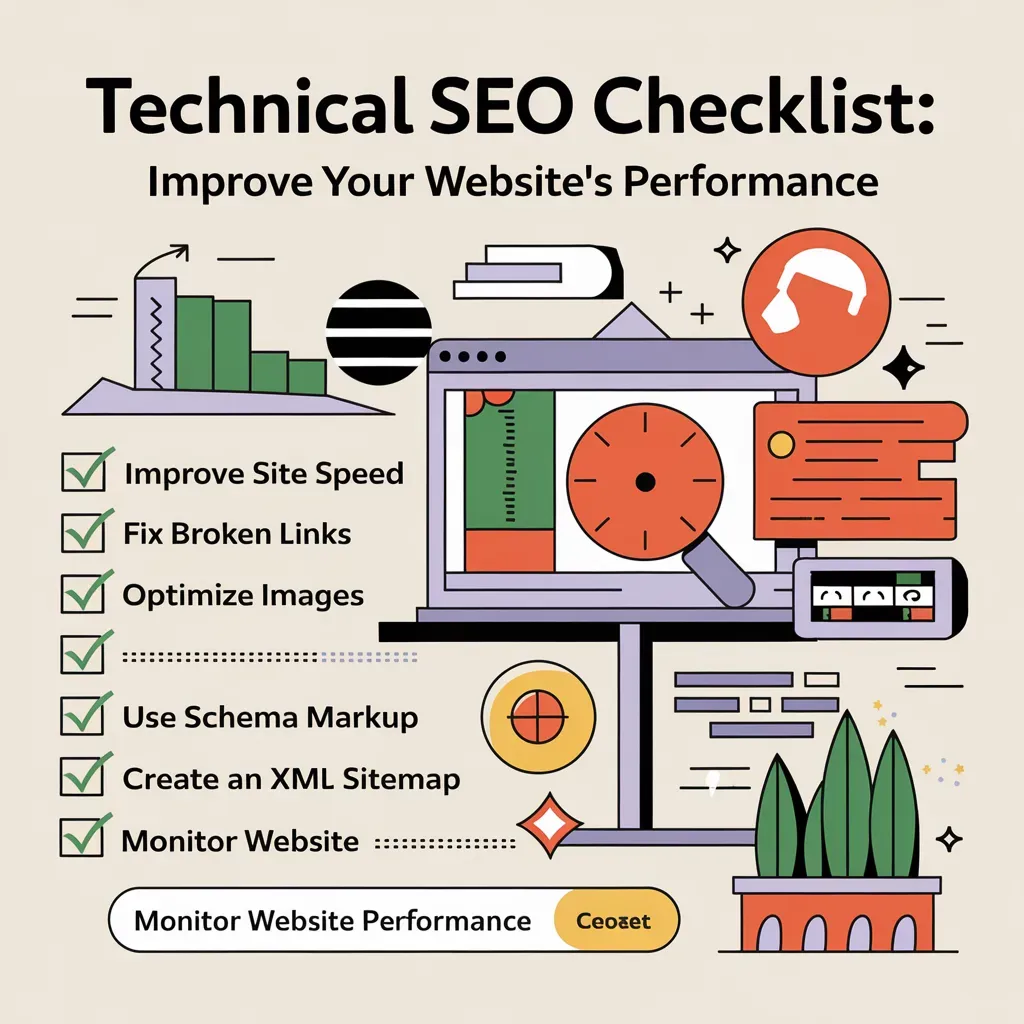
Technical SEO Checklist: Improve Your Website’s Performance
Introduction
Technical SEO is a crucial part of optimizing your website to improve search engine rankings and user experience. By focusing on the backend structure, site speed, indexing, and more, you can ensure search engines properly crawl and index your site. This guide provides a comprehensive technical SEO checklist to help you enhance your website’s performance.

1. Website Crawling and Indexing
1.1 Check Robots.txt File
Ensure your robots.txt file is correctly configured to allow search engines to crawl important pages.
Use Disallow directives only for pages you don’t want indexed.
1.2 Optimize XML Sitemap
Submit an updated XML sitemap to Google Search Console and Bing Webmaster Tools.
Ensure all indexed pages are included and exclude irrelevant or duplicate pages.
1.3 Fix Indexing Issues
Use Google Search Console’s Coverage Report to identify pages blocked from indexing.
Implement proper canonical tags to avoid duplicate content issues.
2. Site Speed and Performance Optimization
2.1 Improve Page Load Speed
Use Google PageSpeed Insights or GTmetrix to analyze page speed.
Optimize images using modern formats (WebP, AVIF) and compression tools.
Enable lazy loading for images and videos.
2.2 Minimize HTTP Requests
Reduce unnecessary scripts, CSS, and images.
Combine multiple CSS and JavaScript files where possible.
2.3 Implement a Content Delivery Network (CDN)
Use a CDN to serve static files from the nearest server to users.
Popular options include Cloudflare, Akamai, and Amazon CloudFront.
2.4 Enable Browser Caching
Set caching policies for static files to reduce load times for repeat visitors.
3. Mobile-Friendliness
3.1 Implement Responsive Design
Ensure your website is fully responsive across all devices.
Test mobile usability using Google’s Mobile-Friendly Test.
3.2 Optimize for Core Web Vitals
Improve Largest Contentful Paint (LCP) by optimizing server response times.
Reduce Cumulative Layout Shift (CLS) by ensuring elements don’t shift unexpectedly.
Enhance First Input Delay (FID) by optimizing JavaScript execution.
4. Secure Your Website
4.1 Install SSL Certificate (HTTPS)
Ensure your website uses HTTPS for security and trust.
Redirect all HTTP URLs to HTTPS to avoid duplicate content issues.
4.2 Protect Against Mixed Content Issues
Ensure all images, scripts, and resources load over HTTPS.
4.3 Implement Security Headers
Use headers like Content Security Policy (CSP) and X-XSS-Protection to prevent attacks.
5. URL Structure and Navigation
5.1 Optimize URL Structure
Use short, descriptive, and keyword-rich URLs.
Avoid special characters, numbers, or excessive parameters.
5.2 Implement Breadcrumb Navigation
Use breadcrumbs to improve site structure and user navigation.
Ensure breadcrumbs appear in search results using structured data.
5.3 Fix Broken Links and Redirects
Identify and fix 404 errors using tools like Screaming Frog or Google Search Console.
Use 301 redirects for permanently moved pages instead of 302 redirects.
6. Structured Data and Schema Markup
6.1 Add Schema Markup
Implement structured data for rich snippets (e.g., FAQs, reviews, events).
Use Google’s Structured Data Testing Tool to validate your markup.
6.2 Optimize Open Graph and Twitter Cards
Ensure social media previews display correctly by setting Open Graph and Twitter meta tags.
7. Log File Analysis and Error Monitoring
7.1 Analyze Server Logs
Check how search engine bots interact with your site.
Identify crawl errors, slow-loading pages, and broken links.
7.2 Monitor Website Errors
Use Google Search Console’s Coverage Report to track and fix indexing errors.
Set up alerts for 404 errors, server downtime, and crawl anomalies.
Conclusion
Technical SEO is an ongoing process that requires regular monitoring and optimization. By following this checklist, you can enhance your website’s performance, improve search visibility, and provide a seamless user experience. Regularly audit your website and stay updated with search engine algorithm changes to maintain a competitive edge.